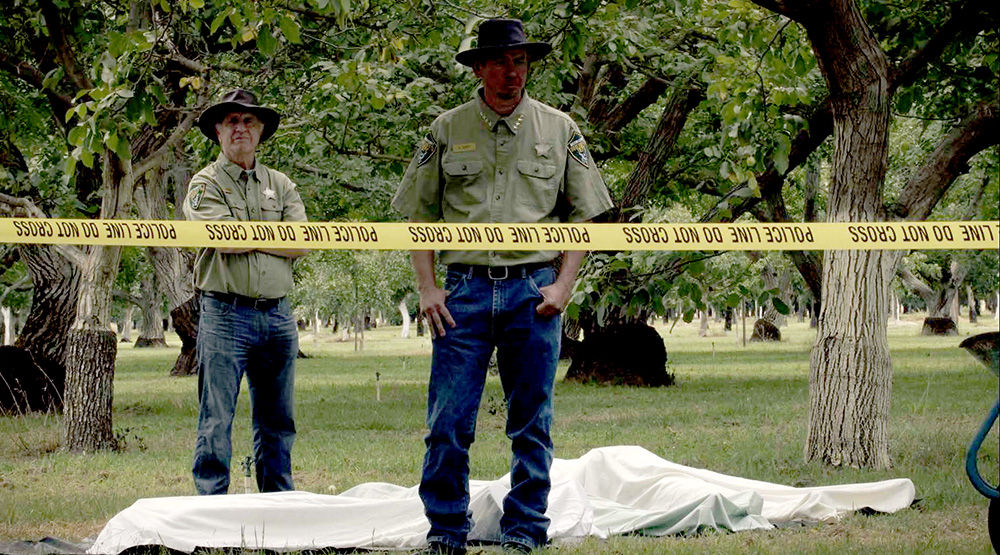Producer-Writer Patricia V. Davis said she was determined that her first movie, set in a California farming community, would avoid the worn out Hollywood trope of a chainsaw-yielding maniac and aw-shucks yokels that seem omniscient in horror films set in farming community.

Movies that impress aficionados like me, we usually see at least one more time. Those that really impress, we usually make time to see several times. And those that blow our minds, we may see ad infinitum.
Banking on their marketing, promotion and publicity designs, one doesn’t have to be a film aficionado to see that LYVIA’S HOUSE’s filmmakers were shooting for a towering grand slam of a film – that their derring-do, panache and creativity had them anticipating a VAVA VOOM.
They did well – got recognition from several film festivals – but fell short of the anticipated VAVA V though the film definitely deserves a resee or two – maybe even three. Nevertheless, many who see this film ready die, so to speak, to know what the filmmaking folks are planning for their next grand surprise. But this reviewer-writer believes VAVA V is still possible if the filmmakers consider editing 30 minutes out of the 114 minutes total runtime minutes-there-abouts running time as well as use sage tweaking and nip-and-tucking here and there.
Hint: I-can’t-believe-they-did-this and I-can’t-believe-they-dared-to-do-that moments, scenes, passages are ubiquitous. Cinematography? At least four-stars. Film score, soundtrack and other essentials are more than worthy of mucho thumbs up, ardent backslaps and incredibly more.
Director: Niko Volonakis
Writer: Patricia V. Davis
Cinematographer: Cody Martin
Fantasy, Mystery, Thriller, Cosmic
Insights
“In LYVIA’S HOUSE, we tried to create a sense of duality with the light,” writes Cinematographer Cody Martin, Director of Photography and Lighting CodMartin Films. regarding “the juxtaposition of the shadowless, sun-drenched day scenes, and the moody, contrast-heavy night scenes.” He also wrote that “during the day, the orchards are inviting and playful, but at night they turn into looming silhouette giants that stir up fear and unease.” A brooding sense of fear and unease exists throughout the film – from the opening scenes of the movie. A melancholic eerieness is imbued in the essences of this film.

“One of the most noticeable creative lighting choices you’ll see in the film is the use of green moonlight,” he also writes, adding that he was Inspired by Guillermo Del Taro’s PAN’S LABYRINTH Pan’s Labyrinth in the way he says it used subtle sea-green in place of the dated “blue moon” cinematic cue for moonlight.
“We did utilize blue moon, in flashbacks, as an homage to old cinematic cues, but I loved working with greenish blue moonlight! Shortly before we began production, I watched the HBO series Chernobyl, which managed to invoke visceral feelings of sickness in me. So much so, I could only watch a few episodes at a time.
There is a theme of surrealism throughout the film. “We wanted to bend that reality with the light … We wanted the emotional states of the characters to be reflected in the lighting, and as they descend into madness the lighting unhinges itself from reality, with the use of fire light, shadowy negative space, and otherworldly colors.
“In one of the final and most intense scenes of the film, the color is a fiery orange, to depict the anger and rage the characters are feeling, even though the color is not relevant to reality.”
For films, he says, the fastest way to communicate emotion is to use light. “As Director of Photography and Lighting Director, I want to speak to the audience about how they should be feeling before a sound was heard – or a word was spoken.”
 Patricia V. Davis Producer-Writer’s Statement reveals how fortuitous and serendipitous circumstances – plus the success from her best selling novels based on her real-life experiences – propelled her across the goal line of cinematic success for her first deep involvement with filmmaking. She seems to have a muse that many writers would be willing to die for.
Patricia V. Davis Producer-Writer’s Statement reveals how fortuitous and serendipitous circumstances – plus the success from her best selling novels based on her real-life experiences – propelled her across the goal line of cinematic success for her first deep involvement with filmmaking. She seems to have a muse that many writers would be willing to die for.
An essence of the following historical facts were some of the fertile seeds that got her juices flowing. Juan Corona Vallejo was convicted of slaying 25 Mexican migrant farm workers whose buried bodies were eventually found in peach orchards along the Feather River in Sutter County, California, in 1973. An appellate court overturned the conviction in 1978 because of evidence of incompetent legal representation and he was granted a new trial.
In 1982, he was again found guilty on all counts.
He was sentenced again to a life in a California State Prison, Corcoran, and died in 2019. “The film diverts completely from the horror from which it sprang,” she writes, but acknowledges LIVIA’S HOUSE is “what might have been the fallout, in my imagination, of those murders 20 years after they were committed.”

“We couldn’t afford to produce a period piece, so I set the killings in 1998, with the main focus of action taking place in 2018” She showed her script to a screenwriter friend who helped her sell it. “That’s what gave me the courage to take the leap to produce it myself.”
“A good portion of the money we raised came from my readers, which was wonderful of them, and we even procured a few investors,” she also writes in her statement
A Blissful Coincidence: Cinematographer Cody Martin was born and raised in the area. His family operated a walnut orchard. “If I had to guess, I’d say he’s probably the only son of farmers who became a filmmaker.” Cody, according to Davis, heard through a community grapevine about the filmmaking and offered support. Other filmmakers in the area contributed a wealth of film equipment for nominal fees.
“But it was our farm neighbors who really got behind us. It was a kick for them that a film about life in a rural town was being made by the wife of one of ‘the Davis boys.’ They assisted in every way they could, from offering us locations and vehicles – even a single-engine plane – free of charge, to volunteering as background actors.

“Their help, along with the fantastic direction, score, and editing by Niko Volonakis, the incredible acting, raised the production value on Lyvia to far beyond the five figures for which she was produced. I’m so thankful for all of them – our sponsors and supporters, our neighbors, our team.”

Publisher, Editor Gregg W. Morris
Can be reached at gregghc@comcastnet, profgreggwmorris@gmail.com